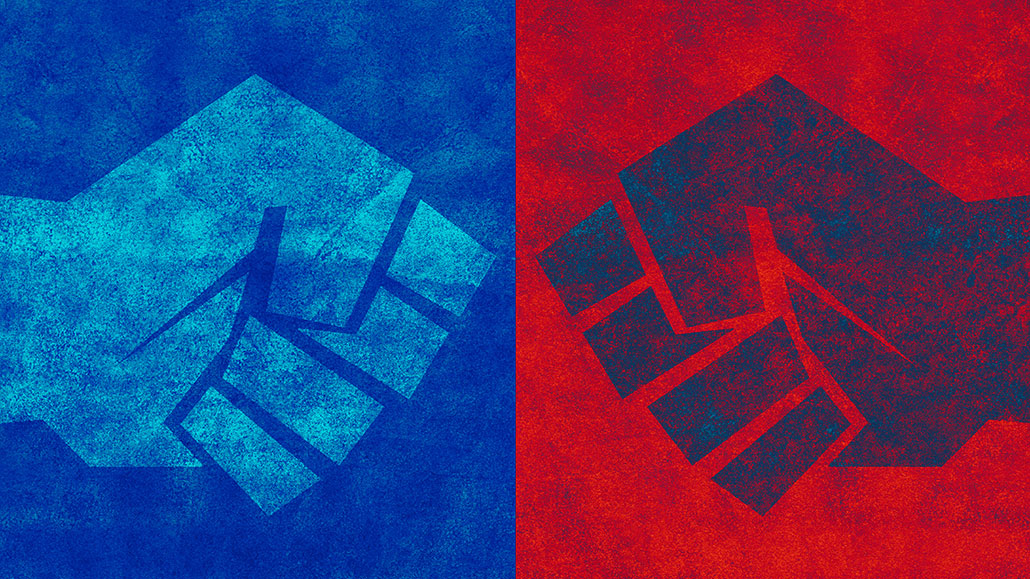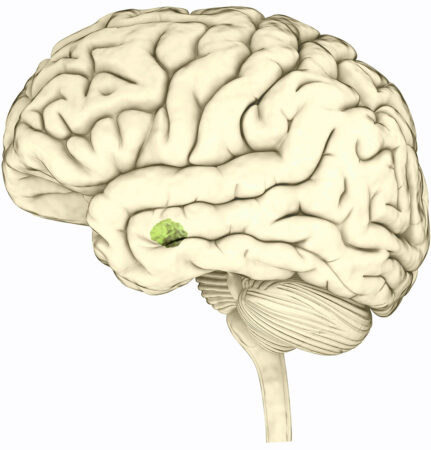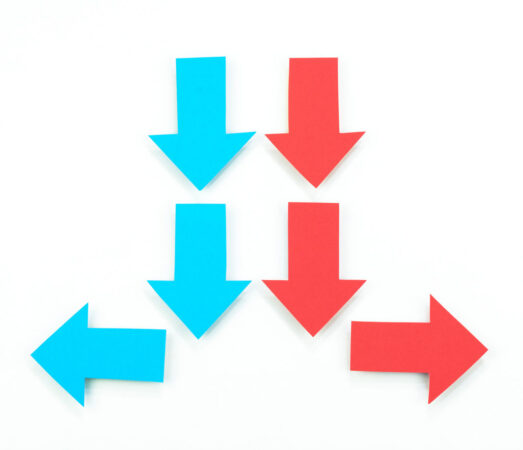Our brains might help explain why people disagree on politics
Human evolution may have helped differing views persist over time

Political elections can bring out strong emotions and bitter disagreements, even between friends and loved ones. It may help to know that research finds it’s natural for groups of people to see things differently, due to how our brains respond to important situations.
SEAN GLADWELL/Moment/Getty Images Plus
Share this:
- Share via email (Opens in new window) Email
- Click to share on Facebook (Opens in new window) Facebook
- Click to share on X (Opens in new window) X
- Click to share on Pinterest (Opens in new window) Pinterest
- Click to share on Reddit (Opens in new window) Reddit
- Share to Google Classroom (Opens in new window) Google Classroom
- Click to print (Opens in new window) Print
Elections tend to bring out strong emotions in people. As voters evaluate the candidates, emotions can rise. Political disagreements may emerge. Even between loved ones, friends or neighbors, discussions can turn bitter. And this discord can affect everyone, even those who aren’t able to vote. But it may help to know that research finds such challenging viewpoints are natural. They can arise from how our brains respond to situations that could have big impacts.
In fact, being able to see things in multiple ways may have helped early humans survive tough times. It may have given them an evolutionary advantage.
The role of governments (and the leaders who run government) is generally known as politics. Scientists who study the brain and those who study politics have teamed up to create a field called “neuropolitics.” Their work explores what may lead us to view the people who run for political office in particular ways. And their findings might help us better understand each other.
Using brain scans of people with different political views, scientists have been scouting for different patterns of electrical activity. People with conservative views (see box) use different parts of their brains when assessing risks than do those with liberal views, some studies now show. They also have different physical reactions to threats.

Diamantis Petropoulos Petalas is a psychologist in Athens at the American College of Greece. He worked with a team in the Netherlands to analyze the brain scans of more than 900 people. They focused on a region called the amygdala. It helps us make decisions and control our emotions. “It is also highly involved in things like the detection of threat,” says Petalas. It’s like an alarm that alerts you to things that might be dangerous or need our immediate attention.
Compared to people who hold liberal views, the amygdala was slightly larger, on average, in people with conservative views. It seems conservatives may be more tuned in to noticing things that are risky. Petalas’ team published this October 18 in iScience.
These findings build on others showing that the amygdala may be more active in conservatives.
Darren Schreiber works at the University of Exeter in England. He was one of the first to study politics and the brain. He’s been using imaging to see how different brain regions are involved in the way people think about politics.
He was the lead author of one 2013 study that looked at MRI brain scans of liberals and conservatives. The scans took place while each group played a simple risk-taking game. Such imagery is known as functional MRI.
They made similar choices in the game. But what parts of their brain lit up as active differed as they played. Conservatives had more activity in their amygdala. It responds most strongly to fear and pleasure. Liberals showed more activity in what’s known as the insula. It processes a wider range of emotions. Disgust, empathy and pain are among them.
People may think differently about risk, depending on their views, this study found.
Patterns of brain activity are surprisingly good at predicting someone’s views, Schreiber noted. As part of the study, people shared their parents’ political views. Those data let him correctly guess how someone would vote in more than two out of every three instances. That’s pretty high, he says.
But the brain scans were even better.
They predicted political views in more than four out of every five instances. “We were really shocked,” he says. “Looking at brain scans was better at guessing their views than knowing the views of the parents they grew up with.”
How ancient humans influenced today’s political beliefs
Another part of the brain is slightly larger in conservatives, Petalas’ research shows. It’s the fusiform gyrus. This area plays a role in recognizing faces. “It tries to understand social emotions by putting people in categories,” Petalas says. “Like ones you can trust or ones to be scared of.”
People are social creatures. Throughout history, our survival has depended on forming groups.
For our early ancestors, being alone was risky. But if your group gets too big, it’s hard to know and trust everyone. Petalas’ work suggests that people with conservative views may naturally focus more on sorting people into groups. That may help them decide who seems trustworthy or who might pose a threat.
John Hibbing is a political scientist who recently retired from the University of Nebraska-Lincoln. But he long studied the biology behind people’s politics. People tend to form groups today because it helped our ancestors survive, he says. And today, people choose to group with those who share their ideas about how the world should work. Such beliefs can be shaped by our evolutionary past.
“Some people want policies that protect traditions and their way of life from outsiders,” Hibbing says. “Others prefer policies that welcome new ideas.” He thinks this can help explain why politics feels so divided.
Each way of thinking may have advantages. But which seems best may depend on the situation. So, evolution helped multiple views persist through time. For instance, a group that keeps to itself might not grow or might run out of resources. At the same time, one that mixes widely with others could be at risk from outside diseases or conflict.
If the whole population makes the same choice and it turns out badly, we could be doomed. Instead, experts suggest groups fare better with two ways of thinking: One focuses on protecting the group while the other is open to new people and ideas. Those could underlie different political views today. For instance, it might play out as how people feel about immigration or gun rights.
Is being so divided today a good thing?
Can we learn to accept that many points of view are important? Matt Qvortrup is hopeful. He’s a political-science researcher at Coventry University in England. He wrote a book this year called The Political Brain. “We are endowed with the ability to discuss and debate,” he says. “And we can use what we learn as a way to understand and humanize the brains of others.”
That gives us a choice about how we respond, he says. “We are often controlled by our primal brain, which is guided by fear and the desire to survive,” he says. But we evolved to talk and solve problems. He now believes we can learn to listen better, too.
Maybe you’ve been warned not to talk about politics at a family event. Or you’ve heard someone you care about say bad things about someone else because of a candidate they support. It may feel scary to share your opinions or ask questions to learn more.
Having different views doesn’t mean someone is wrong or bad. Learning more about where these different opinions come from might help us find common ground. It could make it easier to talk and learn from others — even about tricky topics, such as politics.
Brain imaging is one more tool to help people understand differences. Learning more now will make you a more informed voter in the future. Even for young people, Petalas says, “It’s really important to engage … with politics in a healthy and kind manner if we want to continue to talk about democracy.”
How conservatives and liberals differ

There are generally two major political views: conservatives and liberals. The first group’s views are often said to lean “right” of center (or neutral). Liberals are commonly described as being “left” of center. Such differences can get color tags. Conservatives are red. Liberals are described as blue. These are broad categories, however. People in each group seldom agree on every issue. And individuals can fall within a broad range of “moderates” between the far left or far right.
Generally, conservatives prefer to hold onto — or conserve — longstanding ways of doing things. They prefer giving government a smaller role in people’s lives (and paying less in taxes to fund this role). But they usually do tend to favor a strong national defense (military). Conservatives would prefer people take primary responsibility for their own needs. By that, they generally think the government should do less to help individuals out, from education to paying for basic needs.
Liberals are usually more open to change and new ideas. They tend to support a bigger role for the government in education, healthcare and meeting basic needs. Their goal is to help everyone share in similar opportunities.







